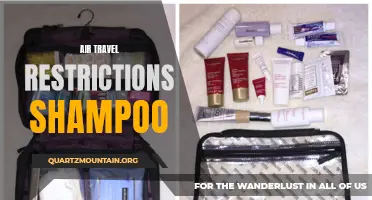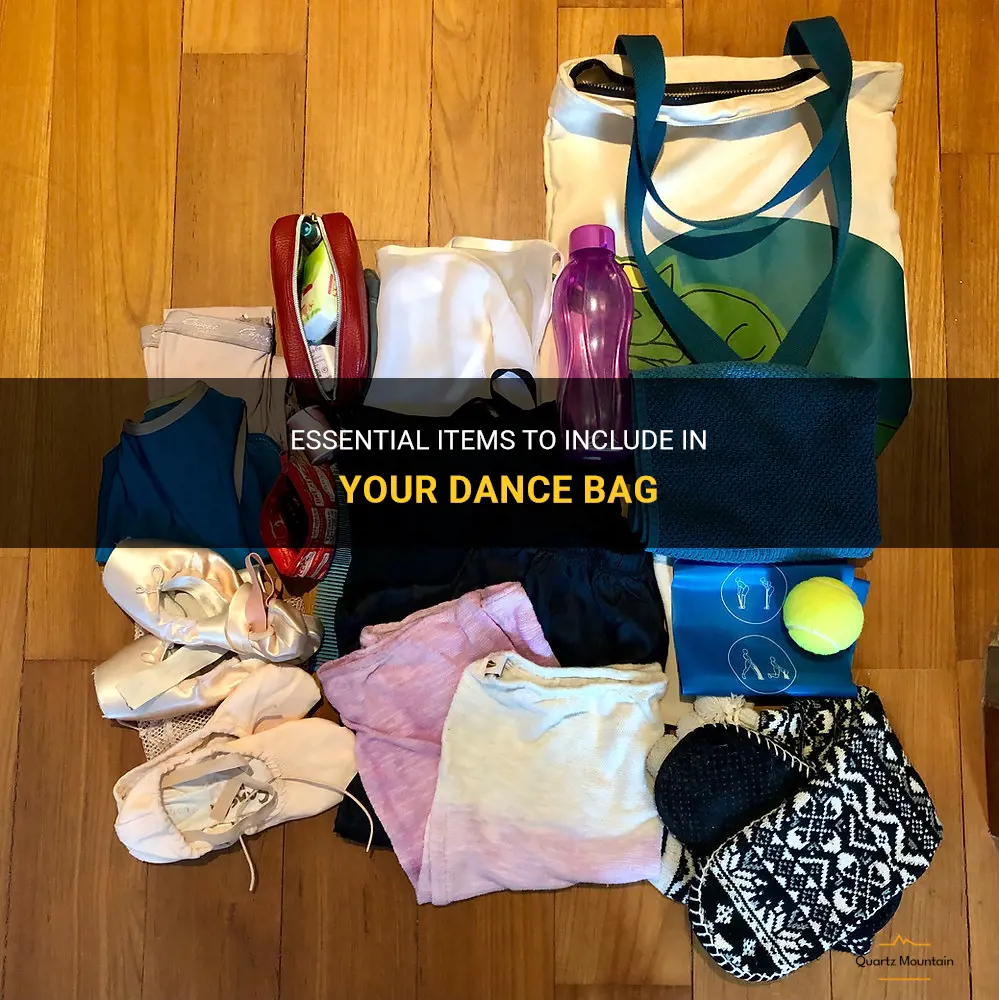
Dance is an art form that requires passion, dedication, and discipline, but it also requires the right tools. Whether you're a ballet dancer, a hip-hop enthusiast, or a ballroom champion, having a well-stocked dance bag is essential. From the perfect pair of dance shoes to extra hair ties and bandaids, this article will guide you through the must-have items to include in your dance bag. Whether you're a seasoned performer or a beginner just starting out, having these essentials on hand will ensure you're always prepared to hit the dance floor.
What You'll Learn
- What are the essential items to pack in a dance bag?
- How should I organize my dance bag to maximize space?
- Are there any specific items I should bring for different types of dance (e.g. ballet, jazz, hip-hop)?
- Should I pack any snacks or drinks in my dance bag?
- Are there any additional items or accessories that are useful to have in a dance bag?

What are the essential items to pack in a dance bag?
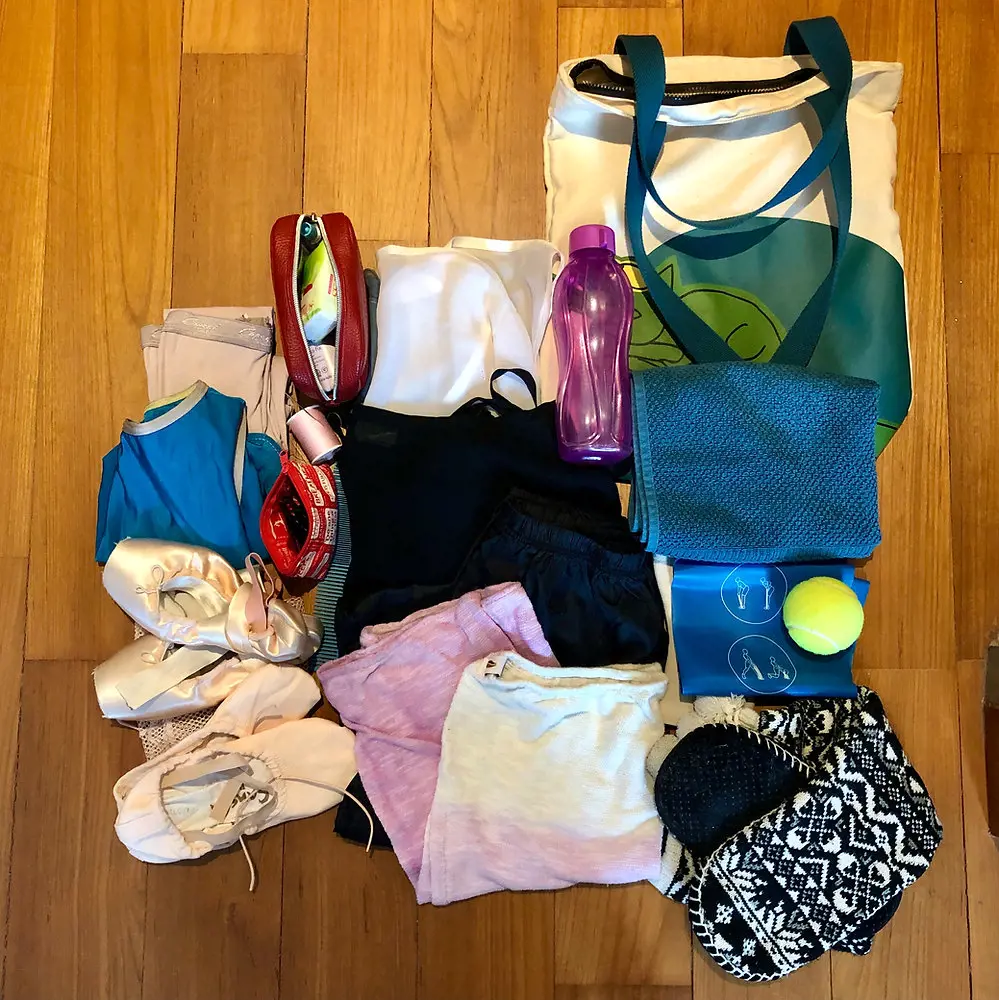
When it comes to dance, having a well-packed dance bag is essential. Whether you are a beginner or an experienced dancer, having all the necessary items in your dance bag can make a big difference in your performance and overall dance experience. In this article, we will discuss the essential items to pack in a dance bag, so you can be prepared for any dance class or performance.
Dance Shoes:
One of the first items you should pack in your dance bag is your dance shoes. Depending on the style of dance you are practicing, you may need different types of shoes. For example, ballet dancers should pack ballet shoes, pointe shoes, and possibly jazz shoes. Hip hop dancers may need sneakers, while tap dancers need tap shoes. Make sure to pack the appropriate shoes for your dance style to ensure comfort and performance.
Dance Clothes:
Comfortable and appropriate dance clothes are essential for any dancer. Pack a few outfits that are suitable for your dance style, such as leotards, tights, leggings, dance shorts, or sweatpants. Additionally, it is important to pack extra clothes in case you sweat or need to change between classes or performances.
Water Bottle:
Staying hydrated is crucial for any dancer, as dancing can be physically demanding. Pack a water bottle in your dance bag to ensure you have access to water throughout your practice or performance. Opt for a reusable water bottle that is easy to carry and refill.
Snacks:
Dancing can be a tiring activity that burns a lot of calories. It is important to fuel your body with the right nutrients to maintain energy levels. Pack healthy snacks such as fruits, nuts, granola bars, or protein bars in your dance bag to have a quick and easy snack option.
Hair Accessories:
For dancers with long hair, hair accessories are essential. Pack hair ties, bobby pins, headbands, or hairnets to keep your hair out of your face and secure during dance routines. Having these accessories readily available in your dance bag will save you time and ensure your hair stays in place.
Dance Accessories:
Depending on your dance style, you may need specific accessories. Ballet dancers may need ballet ribbons, toe pads, or toe spacers. Tap dancers may need tap plates or cleaning supplies for their tap shoes. Jazz dancers may need knee pads or dance belts. Make sure to pack any necessary accessories for your specific style to enhance your performance.
Injury Prevention Tools:
Injury prevention should be a priority for every dancer. Pack items such as resistance bands, foam rollers, or tennis balls to help warm up and stretch your muscles before and after dance sessions. These tools can also be used to alleviate muscle soreness and prevent injuries.
In conclusion, a well-packed dance bag is essential for every dancer. Make sure to pack your dance shoes, appropriate dance clothes, water bottle, snacks, hair accessories, dance accessories, and injury prevention tools. Having these essential items readily available will ensure you are prepared for any dance class or performance, enabling you to focus on your technique and enjoy your time on the dance floor.
Essential Items to Bring for an Overnight Dance Competition
You may want to see also

How should I organize my dance bag to maximize space?
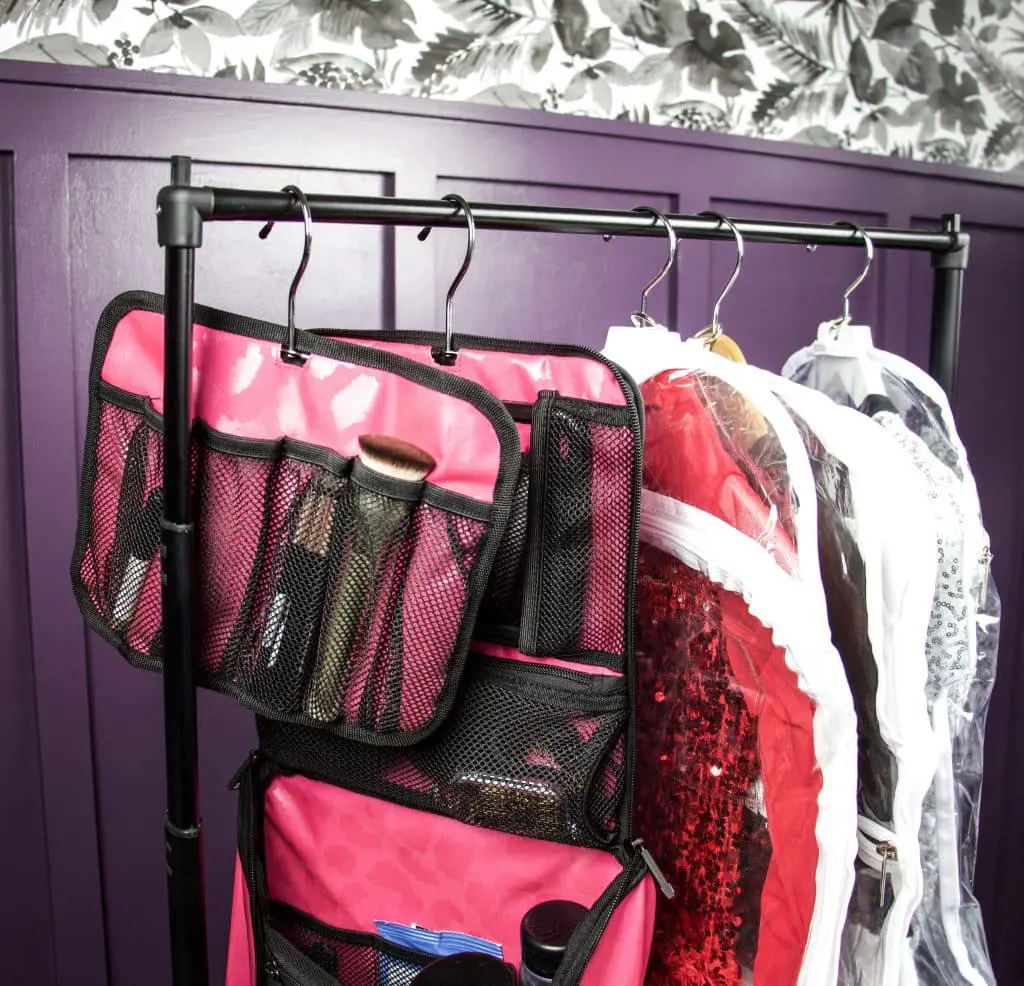
When it comes to dance, having an organized bag can make a big difference in maximizing space and efficiency. Whether you're heading to class, a rehearsal, or a performance, having a well-organized dance bag can save you time and stress. Here are some tips on how to organize your dance bag to maximize space:
- Invest in a good dance bag: Start with a dance bag that has compartments and pockets to help you stay organized. Look for a bag that has a designated space for shoes, water bottles, clothing, and smaller accessories like hair ties and band-aids. This will make it easier to find what you need quickly and keep everything in its place.
- Use packing cubes or ziplock bags: Packing cubes or ziplock bags can be a game-changer when it comes to organizing your dance bag. Use them to separate your different dancewear, such as tops, bottoms, and leotards. This not only keeps everything neat and tidy but also allows you to easily locate what you need without rummaging through the entire bag.
- Roll, don't fold: Rolling your dance clothes instead of folding them can help save space and prevent wrinkles. It also makes it easier to see what you have packed and find specific items quickly. Roll your tops, leggings, and socks before placing them in your bag, and you'll be surprised at how much space you can save.
- Separate clean and dirty items: To avoid mixing your dirty and clean dancewear, consider packing a separate bag or pouch for your used clothes. This will ensure that your clean clothes stay fresh and odor-free. You can use a breathable laundry bag or a ziplock bag for this purpose.
- Utilize shoe compartments: Many dance bags come with dedicated shoe compartments or separate shoe pouches. Take advantage of these spaces by placing your dance shoes in them. This will not only protect your shoes from getting damaged but also free up more space inside your bag for other necessities.
- Pack essential accessories in a small container: Small accessories like hairpins, bobby pins, and hair ties can easily get lost in your dance bag. To keep them organized and easily accessible, consider using a small container, such as a pillbox or a jewelry organizer. This will prevent them from spreading all over your bag and save you the frustration of searching for them when you need them the most.
- Keep a checklist: It's easy to forget to pack important items in the rush of getting ready for dance class or a performance. Keep a checklist of everything you need to pack, including dance clothes, shoes, water bottle, towel, and any personal items like medications or band-aids. This will help you stay organized and ensure that you have everything you need each time you pack your dance bag.
By following these tips, you can organize your dance bag in a way that maximizes space and keeps everything easily accessible. An organized dance bag will not only save you time and stress but also allow you to focus more on your dancing and less on finding your belongings. So, invest in a good dance bag, use packing cubes or ziplock bags, roll your clothes, separate clean and dirty items, utilize shoe compartments, pack essential accessories in a small container, and keep a checklist. Happy dancing!
Essential Items to Pack for a Cross Country Trip with a Pop-Up Camper
You may want to see also

Are there any specific items I should bring for different types of dance (e.g. ballet, jazz, hip-hop)?
_20240219075127.webp)
When it comes to different types of dance, such as ballet, jazz, and hip-hop, there are certain items that dancers should consider bringing with them to enhance their performance and comfort. Whether you are a beginner or experienced dancer, having the right gear and equipment can make a big difference in your overall dance experience. Here are some specific items that you should consider bringing for each type of dance:
Ballet:
- Ballet shoes: Ballet dancers typically wear special ballet shoes that allow for flexibility and movement. There are various types of ballet shoes, including traditional leather ones or canvas ones. Choose the ones that are comfortable and provide good support.
- Leotard: A leotard is a form-fitting garment that is often worn by ballet dancers. It allows the dancer to move freely and shows off their lines and posture.
- Tights: Ballet dancers usually wear tights to enhance the aesthetics of their movements. They come in different colors and styles, so choose ones that match your skin tone or the costume you will be wearing.
- Hair accessories: In ballet, it is important to keep your hair off your face and neck to showcase proper alignment. Bring hair accessories like hairpins, elastics, and a bun cover to keep your hair in place.
Jazz:
- Jazz shoes: Jazz dancers typically wear jazz shoes, which are flexible and have a lot of traction. These shoes allow for quick movements, jumps, and turns.
- Jazz pants or leggings: Jazz dancers often wear loose, comfortable pants or leggings that allow for freedom of movement. Choose ones that are breathable and stretchy.
- Form-fitting top: Jazz dancers usually wear a form-fitting top to show off their lines and movements. It can be a leotard, tank top, or fitted t-shirt.
- Hair ties: Just like in ballet, it is important to keep your hair off your face in jazz. Bring hair ties or headbands to secure your hair.
Hip-hop:
- Sneakers: Hip-hop dancers wear sneakers that provide comfort, support, and traction. Opt for sneakers that are lightweight and have a flexible sole to allow for quick movements.
- Loose pants or joggers: Hip-hop dancers often wear loose pants or joggers that allow for freedom of movement. Choose ones that are breathable and allow you to showcase your style.
- Baggy t-shirt or hoodie: Hip-hop dancers typically wear baggy t-shirts or hoodies that allow for easy movement and add to the urban style. Choose ones that are comfortable and reflect your personal style.
- Accessories: Hip-hop dancers often accessorize their outfits with items like hats, sunglasses, and chains. These can add to your overall performance and style.
These are just a few examples of the specific items you should consider bringing for different types of dance. However, it is important to note that the requirements can vary depending on the dance studio or performance venue. It is always a good idea to check with your dance instructor or the event organizer to ensure you have the appropriate gear for each specific dance style. Remember, the right gear can greatly contribute to your comfort, performance, and overall enjoyment of dance.
Essential Items to Include in a Picky Eater's Lunch Pack
You may want to see also

Should I pack any snacks or drinks in my dance bag?
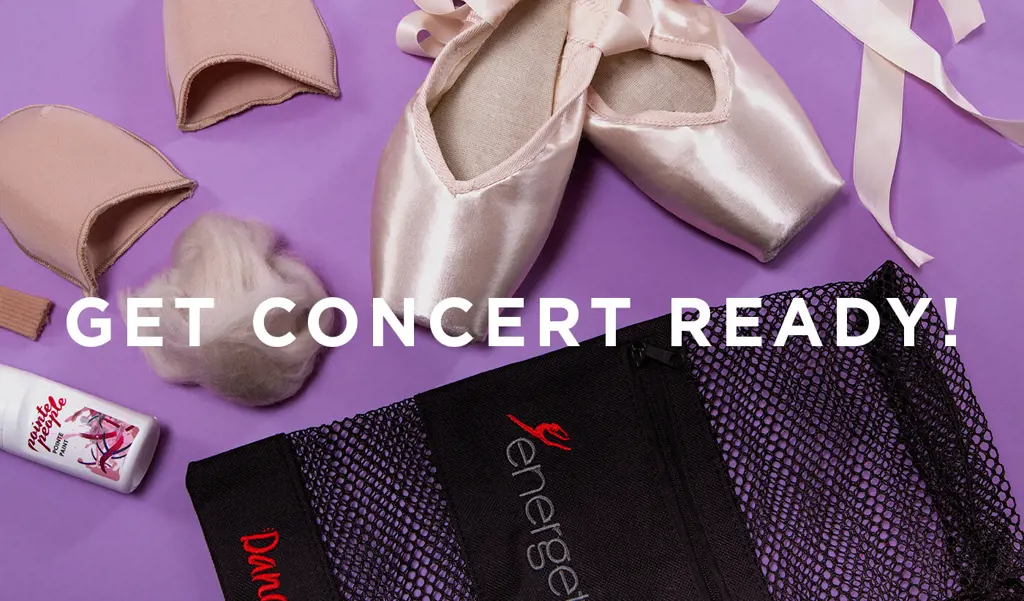
As a dancer, it is important to fuel your body with the right nutrients to maintain energy levels and optimize performance. Packing snacks and drinks in your dance bag can be a great way to ensure you have access to healthy sustenance throughout your practice or performance. In this article, we will discuss why it is beneficial to pack snacks and drinks in your dance bag, what types of snacks and drinks are best, and some examples of what you could include.
Dancing is a physically demanding activity that requires a lot of energy. During practice or performances, you may find yourself feeling tired or fatigued if you haven't properly nourished your body. By packing snacks and drinks in your dance bag, you can provide your body with the necessary fuel to keep going and perform at its best.
Additionally, dance studios or performance venues may not always have healthy food options available, making it important to bring your own. By having snacks and drinks readily available, you can avoid succumbing to unhealthy fast food choices or vending machine snacks.
When it comes to choosing snacks and drinks for your dance bag, it is important to select options that will provide sustained energy and hydration. Here are some top choices:
- Fruits and vegetables: Pack portable options such as sliced apples, baby carrots, or grapes. These are full of vitamins, minerals, and fiber to keep you feeling energized.
- Nuts and seeds: Almonds, walnuts, and sunflower seeds are excellent sources of protein, healthy fats, and nutrients.
- Protein bars: Look for bars that are low in sugar and high in protein. These can provide a quick and convenient source of energy.
- Trail mix: Create your own mix with a combination of nuts, dried fruits, and whole-grain cereal for a balanced snack.
- Water: Staying hydrated is crucial for optimal dance performance. Fill a reusable water bottle and keep it in your dance bag.
Examples of snacks and drinks to pack
To give you an idea of what you could include in your dance bag, here are some examples:
- Apple slices with a small container of almond butter.
- Baby carrots and hummus.
- Greek yogurt and a handful of mixed berries.
- Trail mix with almonds, dried cranberries, and whole-grain cereal.
- Protein bar with minimal ingredients and high protein content.
Remember to pack snacks and drinks that you enjoy and are easy to eat on-the-go. It's also a good idea to pack some extra snacks in case you need an additional energy boost or if practice or performances go longer than expected.
In conclusion, packing snacks and drinks in your dance bag can help you maintain energy levels and ensure you are properly nourished throughout your practice or performance. Choose snacks that provide sustained energy and hydration, such as fruits, vegetables, nuts, seeds, and protein bars. Don't forget to stay hydrated by bringing a reusable water bottle. By making healthy choices and being prepared, you can fuel your body for success in your dancing endeavors.
Packing Essentials for a Memorable Trip to Hinchinbrook Island
You may want to see also

Are there any additional items or accessories that are useful to have in a dance bag?
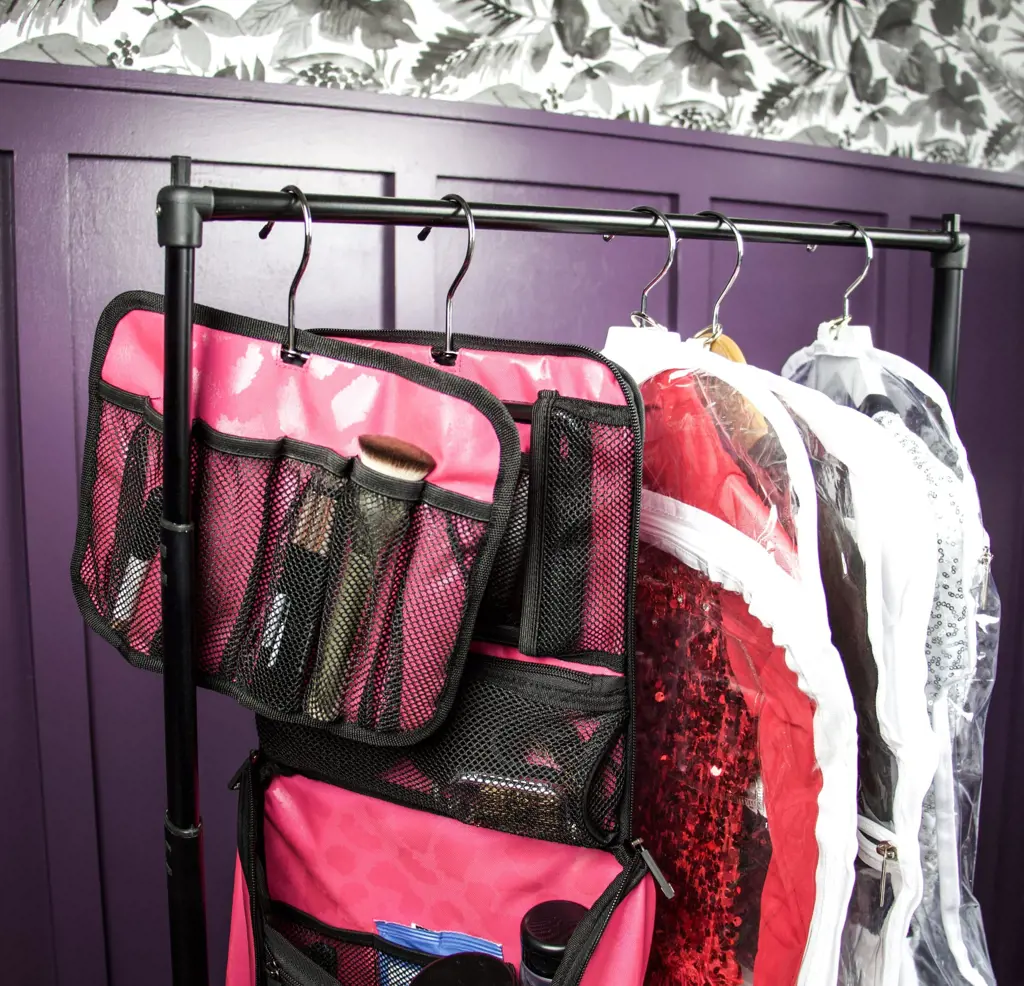
When it comes to a dancer's bag, there are several essential items that are a must-have, such as dance shoes, extra clothes, and water bottles. However, there are also some additional items and accessories that can be incredibly useful to have in a dance bag. These items can help dancers stay comfortable, prepared, and organized, and can even enhance their performance. Here are some of the additional items and accessories that dancers should consider including in their dance bags:
- Yoga mat: A yoga mat can be a great addition to a dancer's bag, especially if they are involved in a dance style that incorporates floor work or stretching. A yoga mat provides a clean and comfortable surface for dancers to stretch on, allowing them to get the most out of their warm-up and cool-down activities.
- Resistance bands: Resistance bands are a versatile and compact tool that can be used to improve strength, flexibility, and technique. Dancers can use resistance bands to target specific muscle groups and work on their turnout, extensions, and balance. These bands are lightweight and can be easily stored in a dance bag, making them perfect for practicing on the go.
- Foot roller or massage ball: Dancing can take a toll on the feet, so having a foot roller or massage ball in the dance bag can provide great relief after a long day of classes or rehearsals. These tools can help to release tension, improve circulation, and alleviate discomfort in the feet. Regular use of a foot roller or massage ball can also help to prevent injuries and maintain foot health.
- Hair accessories: For dancers with long hair, it is essential to have hair accessories such as hair ties, bobby pins, and hairbrushes in their dance bag. These items can help to keep hair out of the face and secure hairstyles during intense movements. It is also a good idea to have spare hair accessories in case they get lost or break during practice.
- Snacks: Dancing requires a lot of physical energy, so having a supply of healthy snacks in the dance bag is important for dancers to refuel and stay energized. Nuts, fruit, protein bars, or trail mix are all excellent options that can provide a quick and nutritious boost between classes or rehearsals.
- Spare tights and leotards: Accidents happen, and it is not uncommon for dancers to rip or tear their tights or leotards during practice. Having spare tights and leotards in the dance bag ensures that dancers can quickly change into fresh and intact clothing, avoiding any discomfort or embarrassment.
- First aid kit: It is always a good idea to have a small first aid kit in the dance bag, containing items such as band-aids, antiseptic wipes, and pain relievers. Dancers frequently push their bodies to the limit, and minor injuries or blisters are not uncommon. Having a first aid kit on hand can help dancers address these issues quickly and continue with their training.
In conclusion, while dance shoes, clothes, and water bottles are crucial items to have in a dance bag, there are also several additional items and accessories that can be useful for dancers. Including items such as a yoga mat, resistance bands, foot roller or massage ball, hair accessories, snacks, spare tights and leotards, and a first aid kit in the dance bag can help dancers stay comfortable, prepared, and organized, and enhance their overall dance experience.
Essential Gear for Pike Fishing Adventures in Canada
You may want to see also
Frequently asked questions
When packing your dance bag, it's important to include essentials such as dance shoes, extra pair of tights, hair ties, and bobby pins. These are the items you will need for every dance class or rehearsal.
Yes, it's always a good idea to pack an extra set of clothes in your dance bag. This can be useful in case you get sweaty during a class or if you have multiple classes in a row and need to change in between.
In addition to the essentials, you may want to consider packing a water bottle to stay hydrated during classes, a small towel to wipe away sweat, and any necessary personal items such as deodorant or a small makeup bag for touch-ups.
To keep your dance bag organized, it can be helpful to use separate compartments or pouches for different items. For example, you can have a designated pocket for dance shoes, a separate one for hair accessories, and another for personal items. This will make it easier to find what you need quickly and avoid items getting tangled or misplaced.




